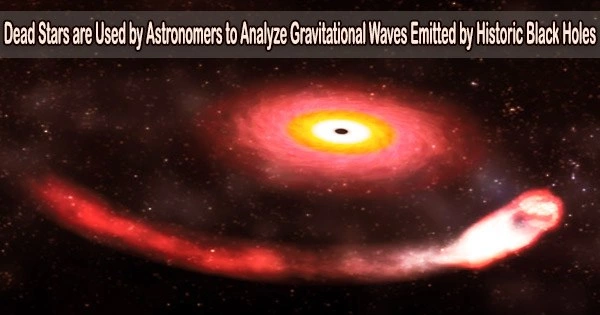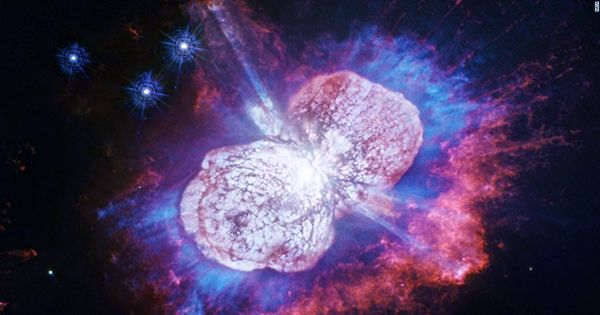The universe’s gravitational waves have been observed by an international team of scientists in a very faint signal. The NANOGrav consortium was able to detect a low-frequency hum from a chorus of spacetime ripples by employing dead stars as a massive network of gravitational wave detectors.
I’m (Chris Impey) an astronomer who studies and has written about cosmology, black holes and exoplanets. I’ve researched the evolution of supermassive black holes using the Hubble Space telescope.
They strongly suspect that the background hum of gravitational waves they recorded was created by numerous historic merging events of supermassive black holes, albeit the researchers behind this new discovery aren’t yet confident about this.
Using dead stars for cosmology
Gravitational waves are ripples in spacetime caused by massive accelerating objects. In his General Theory of Relativity, Albert Einstein postulated that gravitational waves cause periodic shrinkage and expansion of space, which was a prediction of their existence.
Researchers first detected direct evidence of gravitational waves in 2015, when the Laser Interferometer Gravitational-Wave Observatory, known as LIGO, picked up a signal from a pair of merging black holes that had traveled 1.3 billion light-years to reach Earth.
The NANOGrav collaboration is also trying to detect spacetime ripples, but on an interstellar scale. The team made use of pulsars, fast rotating dead stars that radiate radio waves. Because they rotate and can periodically sweep across the Earth with their beams, pulsars act similarly to lighthouses.
The NANOGrav team used pulsars, which revolve at speeds of up to 1,000 times per second and produce pulses that can be timed with an exceptionally high degree of accuracy. The distance between a pulsar and the Earth will very slightly increase and contract as gravitational waves pass by it at the speed of light, slightly altering the interval between ticks.
Because pulsars are such precise clocks, their ticking can be measured with an accuracy of 100 nanoseconds. That lets astronomers calculate the distance between a pulsar and Earth to within 100 feet (30 meters). Gravitational waves change the distance between these pulsars and Earth by tens of miles, making pulsars easily sensitive enough to detect this effect.
Finding a hum within cacophony
The NANOGrav team had to first take steps to account for noise in their cosmic gravitational wave detector. This included radio receiver noise and subtle astrophysics that influenced pulsar activity. Even after taking into account these effects, the team’s method was insufficiently sensitive to pick out gravitational waves coming from certain supermassive black hole pairs.
However, it possessed sufficient sensitivity to pick up as many as a million overlapping signals from the sum of all the huge black hole mergers that have taken place anywhere in the universe since the Big Bang.
It is comparable to hearing the faint strains of a symphony in the distance while in the middle of a busy city street. You can’t pick out a single instrument because of the noise of the cars and the people around you, but you can hear the hum of a hundred instruments. The team had to tease out the signature of this gravitational wave “background” from other competing signals.
The team measured a network of 67 distinct pulsars for 15 years in order to identify this symphony. If gravitational waves from a distant universe caused a blip in one pulsar’s ticking, all of the pulsars the team was monitoring would be similarly impacted.
On June 28, 2023, the team published four papers describing its project and the evidence it found of the gravitational wave background.
The NANOGrav cooperation discovered a hum that is caused by the merger of two black holes, each of which is billions of times more massive than the sun. These black holes create gravitational waves that have frequencies of one billionth of a hertz and rotate very slowly around one another. That means the spacetime ripples have an oscillation every few decades. The researchers had to rely on the pulsars’ extremely precise timekeeping because of the wave’s sluggish cycle.
These gravitational waves are different from the waves LIGO can detect. When two black holes with masses between 10 and 100 times that of the sun merge into one quickly rotating object, gravitational waves are produced that oscillate hundreds of times per second, producing the signals seen by LIGO.
If black holes were tuning forks, the smaller the event would cause the fork to vibrate more quickly and at a higher pitch. LIGO detects gravitational waves that “ring” in the audible range. The black hole mergers the NANOGrav team has found “ring” with a frequency billions of times too low to hear.
Giant black holes in the early universe
The origins of stars and galaxies following the Big Bang have long piqued the interest of astronomers. This new finding from the NANOGrav team is like adding another color gravitational waves to the picture of the early universe that is just starting to emerge, in large part thanks to the James Webb Space Telescope.
Helping scientists understand how the earliest stars and galaxies evolved after the Big Bang is one of the James Webb Space Telescope’s main scientific objectives. James Webb was built to do this by being able to pick up the incredibly faint light from extremely far-off stars and galaxies.
James Webb is essentially a time machine that can look back over 13.5 billion years to view light from the first stars and galaxies in the universe. The further away an object is, the longer it takes the light to arrive to Earth.
It has been very successful in the quest, having found hundreds of galaxies that flooded the universe with light in the first 700 million years after the big bang. The telescope has also discovered the oldest black hole in the universe, which is present in the center of a galaxy that formed only 500 million years after the Big Bang.
These findings are challenging existing theories of the evolution of the universe.
It takes a long time to grow a massive galaxy. Astronomers know the supermassive black holes at the heart of every galaxy, which have masses proportionate to the host galaxies. Therefore, the center of these ancient galaxies probably certainly contains the similarly big black hole.
The problem is that the objects James Webb has been finding are far bigger than current theory says they should be.
These new results from the NANOGrav team emerged from astronomers’ first opportunity to listen to the gravitational waves of the ancient universe. The findings, while tantalizing, aren’t quite strong enough to claim a definitive discovery. That will likely change, as the team has expanded its pulsar network to include 115 pulsars and should get results from this next survey around 2025.
The capacity to examine the period following the Big Bang using gravity waves may prove to be an essential tool as James Webb and other scientists question accepted views of how galaxies evolved.
















